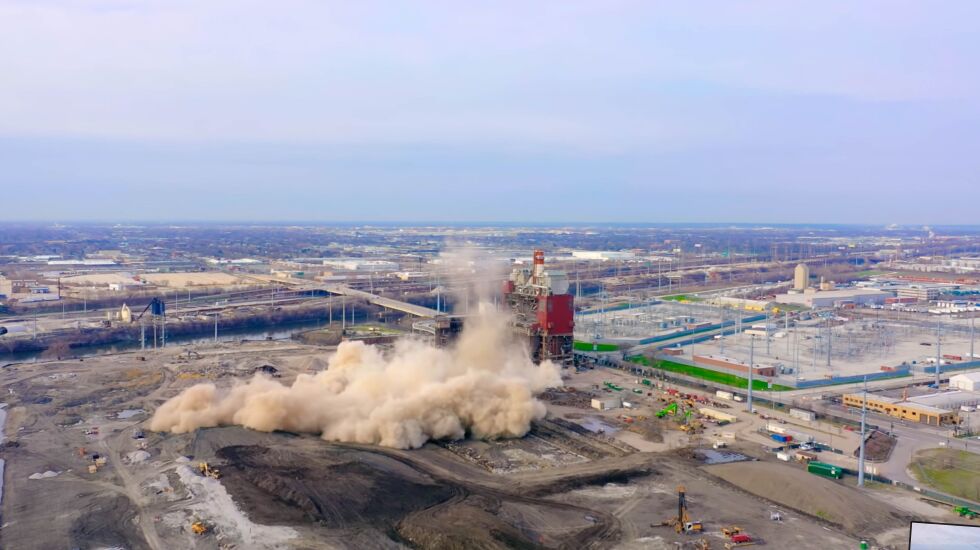
The city’s “negligence and incompetence” allowed a demolition dust storm to blanket Little Village in 2020, according to a scathing watchdog report that also berated City Hall for its response to the debacle.
The previously secret report, finalized in 2021, blames three Chicago officials who were involved, along with developer Hilco, in planning for the implosion of the almost 400-foot chimney at the old Crawford coal-fired power plant. When the structure came tumbling down, it created a massive dust cloud that covered homes, yards, cars and everything else in its path.
Then-Chicago Inspector General Joe Ferguson recommended in his report that two Buildings Department employees, Marlene Hopkins and Jorge Herrera, and Dave Graham, assistant commissioner of the Chicago Department of Public Health, be disciplined for their oversight failure “which should factor the magnitude of the public health, welfare and safety threat to innocent, unwitting community members.”
After open records requests, the Sun-Times last year reported the warnings that the public officials received before the incident advising them to take precautionary steps on Easter weekend in April 2020. A summary of the report was made public a little more than a year ago.
But the full 94-page report has been kept under wraps by Mayor Lori Lightfoot even as community members, the City Council, Ferguson and others have called for its release. Ferguson declined to comment.
In a statement Tuesday, City Hall officials didn’t defend steps leading up to the event but said they acted “swiftly and decisively” afterward and took measures to prevent future problems with demolitions.
The coal plant was being demolished by Hilco to make way for a 1 million-square-foot distribution warehouse for Target. Community members opposed the project, saying a warehouse drawing hundreds of diesel trucks a day was replacing one source of pollution with another.
Community members’ pleas to hold off on the demolition in the early days of the COVID-19 pandemic were ignored, said Kim Wasserman, executive director of the Little Village Environmental Justice Organization.
City “staff played a direct and active role, driving the planned implosion forward and abandoning their duty to inform and protect the public,” Wasserman said after reviewing the report.
The report notes that initially, the plan for demolition involved no implosion. And yet, once the plan was changed, a new permit wasn’t required.
“The original permit process disclosed a planned demolition that would not proceed by way of implosion through explosives,” the report said.
Ferguson’s report found that Herrera and Hopkins should have made sure there was a new permit review for the implosion.
Graham, he said, knew that the new plan “significantly downscaled the dust mitigation measures.”
Ferguson added that all three employees downplayed their parts in the process.
“Hopkins and Herrera continually sought to minimize their role in the implosion process, despite conducting the bulk of coordination with Hilco in planning the city’s involvement,” the report said.
Instead, the two said the city’s Department of Transportation, somehow, was responsible for planning the demolition at Crawford. According to the report, there were multiple instances like this of department officials pointing fingers at each other.
On the question of the Buildings Department and its role, Herrera even researched the matter, the report said. That fact-finding by Herrera “remarkably involved only exploring a publicly available search engine to ascertain [the department’s] responsibilities,” the report found.
Hopkins was promoted months after the Little Village incident and was not disciplined. Herrera, then the chief building inspector, also was not disciplined.
Graham had been recommended for discipline, including firing. The city decided a written reprimand was appropriate.
Asked about a key phone call before the demolition, the report said that “Graham stated that he only attended half of this call and did not pay attention.”
Ferguson’s report also criticized the Lightfoot administration’s haste in assessing penalties against Hilco and its contractors, which paid a combined $68,000 and admitted no wrongdoing in the matter. Hilco paid less than a third of the amount.
“Despite the egregious repercussions of Hilco’s conduct, [the inspector general] will not be recommending any further action against Hilco due to the legally preclusive effect of the city settling with Hilco,” the report said.
Lightfoot administration officials have said the report could not be released, though that has stirred some debate.
Deborah Witzburg, who was appointed inspector general last year, declined to comment on the report other than to say “confidential documents should not be publicly released.”
Rep. Jesus “Chuy” García, who is challenging Lightfoot in the mayoral race, said the report showed “bad decision making” and “lack of accountability.”
Brett Chase’s reporting on the environment and public health is made possible by a grant from The Chicago Community Trust.







